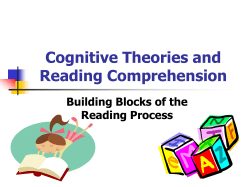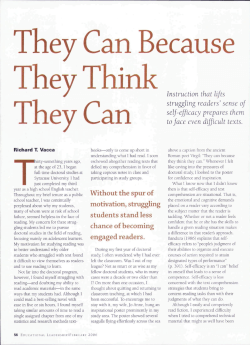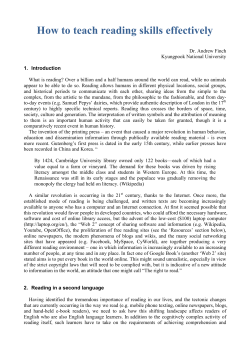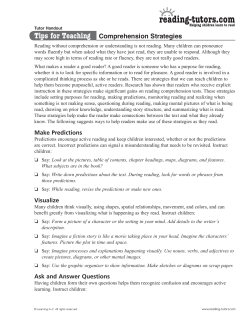
Third Grade Big Ideas and Essential Questions: English-Language Arts
Third Grade Big Ideas and Essential Questions: English-Language Arts Word Analysis, Fluency, & Systematic Vocabulary Development Reading Comprehension Literary Response and Analysis Power Standards: Decoding and Word Recognition (Fluency) 1.3 Read aloud narrative and expository text fluently and accurately and with appropriate pacing, intonation, and expression. Vocabulary and Concept Development 1.4 Use knowledge of antonyms, synonyms, homophones, and homographs to determine the meanings of words. 1.6 Use sentence and word context to find the meaning of unknown words 1.8 Use knowledge of prefixes (e.g., un-, re-, pre-, bi-, mis-, dis-) and suffixes (e.g., -er, -est, -ful) to determine the meaning of words. Power Standards: Comprehension and Analysis of Grade-Level-Appropriate Text 2.2 Ask questions and support answers by connecting prior knowledge with literal information found in, and inferred from, the text. 2.3 Demonstrate comprehension by identifying answers in the text. Power Standards: Narrative Analysis of Grade-Level-Appropriate Text 3.3 Determine what characters are like by what they say or do and by how the author or illustrator portrays them. 3.4 Determine the underlying theme or author's message in fiction and nonfiction text. Big Ideas: Big Ideas: Big Ideas: Decoding and Word Recognition (Fluency) Comprehension and Analysis of Grade-Level-Appropriate Text Narrative Analysis of Grade-Level-Appropriate Text When we read aloud, with fluency, it should: o Contain few errors. o Not be too fast or too slow. o Be read with expression, including changes in pitch, emphasis, and rate. Vocabulary and Concept Development Having a large, rich vocabulary supports becoming a welleducated person. Independent wide reading and word-learning strategies are both essential to acquiring a broad vocabulary. Vocabulary knowledge is critical to comprehension of oral and written language. Knowing how a new word compares/relates to other words helps us understand the new word better. Knowing the meaning of part of a word (e.g., prefixes, suffixes) can provide a clue(s) to the meaning of the whole word. Using the context (words around a word) of an unknown word may help determine the meaning of that word. o To learn a word from context, we must first recognize that the word is unknown. o The information that defines the word may be close to the unknown word or it may be far from the unknown word. o Some contexts may be misleading or not helpful (neutral) in providing clues to the meaning of the word. It is important to use other tools, such as dictionaries or asking adults to help define the word. CUSD 2009: Page 1 of 5 To comprehend means to understand. Good readers comprehend most of what they read, but more importantly, they recognize when they don’t understand. When good readers don’t initially comprehend what they are reading, they use a variety of strategies and skills to further their understanding. We can answer questions about what we read by connecting prior knowledge (things we already know) to information and ideas found in the text. A text may contain: Information that must be inferred by the reader and/or Literal information, which is clearly stated in the text. We can demonstrate our own understanding of a text by identifying evidence (answers) in the text that supports our thinking. The words and actions of characters in a text help us understand their motives, attributes, and feelings. The theme of a piece of literary work is the author’s message or central idea. The theme is a point made about a topic; it’s not just about one set of characters – it’s about people and life in general. The theme of a literary work may be stated or implied. Readers must sometimes make inferences and draw conclusions to determine the theme. An author may express his theme through: o The actions and reactions of the characters as they relate to events throughout the story. o The feelings of the main character. o Conversations and thoughts (that may be repeated throughout the story). o What is learned by the main character in the course of the story. Third Grade Big Ideas and Essential Questions: English-Language Arts Word Analysis, Fluency, & Systematic Vocabulary Development Reading Comprehension Literary Response and Analysis Essential Questions: Essential Questions: Essential Questions: Decoding and Word Recognition (Fluency) Comprehension and Analysis of Grade-Level-Appropriate Text Narrative Analysis of Grade-Level-Appropriate Text What are the attributes of fluent oral reading? Why is it important for us to read aloud with fluency? Vocabulary and Concept Development Why is it important to have a large, rich vocabulary? In what ways can we acquire a broad vocabulary? How does knowing a new word’s relationship to other words help us understand the new word? Can we always determine the meaning of an unknown word using context clues? Explain. In what ways can context be helpful in determining the meaning of an unknown word? In what ways might it be misleading? What does it mean to understand something? Why is it important to understand what we read? Why is it important to recognize when we don’t understand what we are reading? What should we do when we don’t understand what we are reading? How does our prior knowledge help us when we are reading? Do all readers always interpret what they read the same way? Why or why not? How can we demonstrate and support our own understanding of a text? Fluency The ability to read connected text rapidly, smoothly, effortlessly, and automatically with little conscious attention to the mechanics of reading. Accuracy Automatic word recognition Pacing Reading rate (not too fast, not too slow, so that the reader can be understood by the listeners). Expression Prosody (the stress and intonation patterns) Utilizes: emphasis, intonation, rate, language patterns, and phrasing. Intonation The pattern or melody of pitch changed in connected oral reading. CUSD 2009: Page 2 of 5 Why is it important to focus on what characters say and do? What is a theme? Why do literary works have themes? Is a theme always obvious? Why or why not? What must readers do to determine the theme? Third Grade Big Ideas and Essential Questions: English-Language Arts Writing Strategies Writing Applications Written & Oral English Language Conventions Power Standards: Organization and Focus 1.1 Create a single paragraph: a. Develop a topic sentence. b. Include simple supporting facts and details. Penmanship 1.2 Write legibly in cursive or joined italic, allowing margins and correct spacing between letters in a word and words in a sentence. Research 1.3 Understand the structure and organization of various reference materials (e.g., dictionary, thesaurus, atlas, encyclopedia). Evaluation and Revision 1.4 Revise drafts to improve the coherence and logical progression of ideas by using an established rubric. Power Standards: 2.1 Write narratives: a. Provide a context within which an action takes place. b. Include well-chosen details to develop the plot. c. Provide insight into why the selected incident is memorable. 2.3 Write personal and formal letters, thank-you notes, and invitations: a. Show awareness of the knowledge and interests of the audience and establish a purpose and context. b. Include the date, proper salutation, body, closing, and signature. Power Standards: Sentence Structure 1.1 Understand and be able to use complete and correct declarative, interrogative, imperative, and exclamatory sentences in writing and speaking. Grammar 1.2 Identify subjects and verbs that are in agreement and identify and use pronouns, adjectives, compound words, and articles correctly in writing and speaking. 1.3 Identify and use past, present, and future verb tenses properly in writing and speaking. Punctuation 1.6 Use commas in dates, locations, and addresses and for items in a series. Spelling 1.8 Spell correctly one-syllable words that have blends, contractions, compounds, orthographic patterns (e.g., qu, consonant doubling, changing the ending of a word from -y to -ies when forming the plural), and common homophones (e.g., hair-hare). Big Ideas: Big Ideas: Organization and Focus Narratives The sentences in a paragraph must be organized so that the A narrative is a story about actual or fictional events. reader can follow the writer’s ideas. A personal narrative is a story, most often written in A topic sentence provides the focus for a well-written the first person, about a memorable event or series paragraph; it tells what the paragraph is about. of events in the author’s life. Details and facts are the specific words and ideas that tell Good writers provide a context in which the action of about the topic. the story takes place; context tells the reader Penmanship important information, such as who, where, and Legible cursive is necessary in order for others to read your when. writing. Well-chosen details help the reader imagine the Research context, develop the plot, and help give readers Reference materials are organized in a logical, concise, and insight into why the experience is memorable. consistent manner. Learning how various reference Various Forms of Letters materials are organized allows us to use any version of those An effective letter communicates something of materials to easily find information. importance to others and has a positive impact on Evaluation and Revision the person(s) to whom the letter is written. Rubrics allow us to revise and improve our drafts by The information, details, and thoughts shared are comparing what we are writing with specific criteria. determined by the purpose of the letter, and even Good writing is coherent, which means that the ideas are more importantly, by the person(s) to whom the logically connected to each other. letter is written. Good writers revise their drafts to ensure that the ideas There are specific rules about the format and tone progress in a logical sequence from one idea to the next. of formal letters, as well as personal letters, which help keep the focus on the purpose for the letter. CUSD 2009: Page 3 of 5 Big Ideas: Sentence Structure There are different types of sentences that are used to add variety to both spoken and written language. Grammar/ Punctuation Grammar is the set of rules of spoken and written language. Grammar rules and punctuation marks are like freeway signs and traffic signals – they guide readers through the text to help avoid confusion. All verbs must agree in number with their subject; if the subject in a sentence is singular, the verb must be singular – if the subject is plural, the verb must be plural. All the words in our language fit into eight “word groups”, called the parts of speech. Understanding how to properly use the parts of speech in our writing and speaking improves our ability to effectively communicate with others. We can show time in our writing and speaking by using the proper verb tense; the tense of the verb shows when the actions take place. Commas make our writing easier to read by showing the reader where to pause; commas keep words and ideas from running together. Spelling Spelling matters; incorrect spelling causes misunderstandings and confusion, and distracts from the writer’s message. Third Grade Big Ideas and Essential Questions: English-Language Arts Writing Strategies Writing Applications Written & Oral English Language Conventions Essential Questions: Organization and Focus Why is organization important in writing? Why does a well-written paragraph have a topic sentence? Why does a well-written paragraph contain details? Penmanship Why is legible cursive important? Research Why is it important to understand how various reference materials are organized? Evaluation and Revision What do writing rubrics allow us to do? Why do good writers revise their drafts? Why should writing be coherent? Why should writing progress in a logical sequence? What makes a sequence logical? Essential Questions: Narratives What is the difference between a narrative and a personal narrative? Why write narratives? Why is the context of a narrative important? Why is it important to carefully select the details of a narrative? Various Forms of Letters Why are letters important? How do we decide what type of letter to write? What are the differences between formal and personal letters? Essential Questions: Sentence Structure Why is it important to use different types of sentences when we speak and write? Grammar/Punctuation Why is the correct usage of the rules of grammar important? Why is subject-verb agreement important? Why is it important to use the parts of speech correctly? Why is it important to use the correct verb tense when speaking and writing? How do commas make our writing easier to read? Spelling Why does spelling matter? CUSD 2009: Page 4 of 5 Third Grade Big Ideas and Essential Questions: English-Language Arts Listening and Speaking Strategies Speaking Applications Power Standards: Comprehension 1.1 Retell, paraphrase, and explain what has been said by a speaker. Organization and Delivery of Oral Communication 1.6 Provide a beginning, a middle, and an end, including concrete details that develop a central idea. Power Standards: Descriptive 2.3 Make descriptive presentations that use concrete sensory details to set forth and support unified impressions of people, places, things, or experiences. Big Ideas: Comprehension: Good listening takes both our ears and our mind. Learning by listening: o Involves understanding what we hear. o Involves connecting what we hear to what we already know. o May involve being able to explain what has been said by a speaker. Organization and Delivery of Oral Communication A good oral presentation has a central idea, or focus, which should be consistent throughout. The central idea is developed in part by having a clear beginning, middle, and ending. The concrete details are directly related to the central idea, and enhance the listeners’ understanding. Big Ideas: Descriptive When giving a formal presentation, a speaker is sharing information with a group; it is important to have all thoughts and ideas planned out ahead of time. Good speakers consider their audience and the purpose of their presentation. Well-chosen details help support the purpose of the presentation; details can help inform, entertain, persuade, and/or demonstrate. Concrete sensory details help unify the ideas, descriptions, facts, and/or opinions of the speaker. Essential Questions: Comprehension Why does good listening take both our ears and our minds? What does a listener’s explanation of what he/she has heard reveal about his/her understanding? Essential Questions: Descriptive What process should we follow when preparing to make a presentation? Why do we include details in oral presentations? Organization and Delivery of Oral Communication What is a central idea? How is a central idea developed and maintained throughout a presentation? CUSD 2009: Page 5 of 5
© Copyright 2025





















